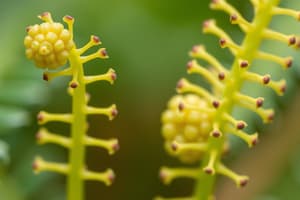Podcast
Questions and Answers
What type of leaves do pteridophytes possess that distinguishes them from bryophytes?
What type of leaves do pteridophytes possess that distinguishes them from bryophytes?
- True leaves (megaphylls) with veins (correct)
- Scale-like leaves with limited surface area
- Simple leaves without veins
- Microphylls with no vascular tissue
What is the primary role of the sporophyte generation in the life cycle of pteridophytes?
What is the primary role of the sporophyte generation in the life cycle of pteridophytes?
- Generating spores through meiosis (correct)
- Creating vegetative structures for photosynthesis
- Dispersing seeds for reproduction
- Producing gametes through mitosis
During which geological period did pteridophytes first evolve?
During which geological period did pteridophytes first evolve?
- Carboniferous period
- Triassic period
- Devonian period (correct)
- Jurassic period
What class do whisk ferns belong to in the classification of pteridophytes?
What class do whisk ferns belong to in the classification of pteridophytes?
How do pteridophytes contribute to soil quality in ecosystems?
How do pteridophytes contribute to soil quality in ecosystems?
What is the approximate number of known species of pteridophytes?
What is the approximate number of known species of pteridophytes?
What is the process by which gametes are produced in the gametophyte generation of pteridophytes?
What is the process by which gametes are produced in the gametophyte generation of pteridophytes?
What natural function do pteridophytes serve by acting as indicator species?
What natural function do pteridophytes serve by acting as indicator species?
Flashcards are hidden until you start studying
Study Notes
Structure
- Pteridophytes, also known as ferns, have a vascular system with xylem and phloem tissues
- They have true leaves (megaphylls) with veins, unlike bryophytes
- Roots are underground stems that produce adventitious roots
- Stems can be rhizomatous (underground) or aerial
- Leaves can be simple or compound, with sporangia (spore-producing structures) on the underside
Evolution
- Pteridophytes evolved from terrestrial plants around 400 million years ago during the Devonian period
- They were among the first plants to colonize land, playing a crucial role in shaping the Earth's ecosystem
- Over time, they adapted to various environments, leading to the diversity of species seen today
Life Cycle
- The life cycle of pteridophytes consists of two generations: sporophyte and gametophyte
- Sporophyte generation:
- Produces spores through meiosis
- Spores disperse and germinate into gametophytes
- Gametophyte generation:
- Produces gametes (sperm and egg cells) through mitosis
- Fertilization occurs, resulting in a zygote that grows into a new sporophyte
Classification
- Pteridophytes are classified into four classes:
- Psilotopsida (whisk ferns)
- Equisetopsida (horsetails)
- Marattiopsida (giant ferns)
- Polypodiopsida (leptosporangiate ferns)
- There are approximately 12,000 known species of pteridophytes
Ecological Role
- Pteridophytes play a vital role in many ecosystems:
- They help create and maintain soil quality through decomposition and nutrient cycling
- They provide habitat and food for various animals, such as insects and amphibians
- They contribute to the global carbon cycle through photosynthesis and respiration
- They can act as indicator species for environmental pollution and climate change
Characteristics
- Pteridophytes, also known as ferns, have a vascular system with xylem and phloem tissues
- True leaves (megaphylls) with veins distinguish them from bryophytes
- Roots are underground stems that produce adventitious roots
- Stems can be rhizomatous (underground) or aerial
- Leaves can be simple or compound, with sporangia (spore-producing structures) on the underside
Evolutionary History
- Pteridophytes evolved from terrestrial plants around 400 million years ago during the Devonian period
- They were among the first plants to colonize land, shaping the Earth's ecosystem
- Over time, they adapted to various environments, leading to the diversity of species seen today
Life Cycle
- The life cycle consists of two generations: sporophyte and gametophyte
- Sporophyte generation produces spores through meiosis, which disperse and germinate into gametophytes
- Gametophyte generation produces gametes (sperm and egg cells) through mitosis, fertilization occurs, resulting in a zygote that grows into a new sporophyte
Classification
- Pteridophytes are classified into four classes: Psilotopsida (whisk ferns), Equisetopsida (horsetails), Marattiopsida (giant ferns), and Polypodiopsida (leptosporangiate ferns)
- There are approximately 12,000 known species of pteridophytes
Ecological Importance
- Pteridophytes help create and maintain soil quality through decomposition and nutrient cycling
- They provide habitat and food for various animals, such as insects and amphibians
- They contribute to the global carbon cycle through photosynthesis and respiration
- They can act as indicator species for environmental pollution and climate change
Studying That Suits You
Use AI to generate personalized quizzes and flashcards to suit your learning preferences.




